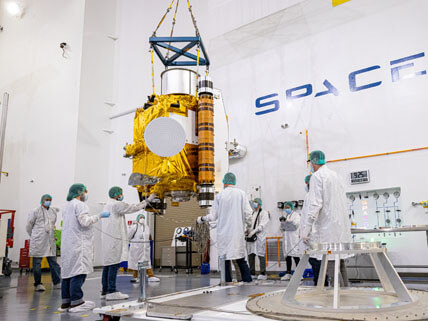
After moving to SpaceX’s payload processing facility on Vandenberg Space Force Base in California, DART team members carefully removed the spacecraft from its shipping container and moved it to a low dolly.
On November 24, 2021, the National Aeronautics and Space Administration (NASA) launched a spacecraft from Vandenberg Space Force Base in California. This spacecraft is aimed at Dimorphos—an asteroid more than 6 million miles away. This mission is one of the first tests of NASA’s planetary defense initiatives.
Although it may sound like the plot of a disaster movie, you can rest assured that Earth is not in any immediate danger of being hit by an asteroid. At least, not one large enough to end all life on the planet. Part of NASA’s mission is planetary defense. In this role, NASA monitors near-Earth objects (NEOs) and evaluates their potential risks.
NEOs are asteroids, comets, and other space objects that orbit our Sun. These objects are considered near-Earth because they are within 30 million miles of Earth’s orbit. Currently, there are more than 20,000 NEOs in our solar system. If one of these objects were to drift into Earth’s orbit, how might we defend our planet?
This is the question NASA hopes to help answer with the DART mission. DART stands for Double Asteroid Redirection Test. If Dimorphos—the target asteroid—were in an orbit to impact Earth (it is not), NASA would classify it as a potentially hazardous object (PHO). PHOs are asteroids (or other space objects) large enough to damage Earth’s surface.
Dimorphus is more than 160 meters wide (more than 500 feet). The golf-cart-sized DART spacecraft will be traveling at more than 15,000 miles an hour. The collision between the two should knock Dimorphus slightly off course. If successful, this would be enough of a course change to divert the asteroid from impacting Earth. That is if Dimorphus was headed toward Earth (it is not).
Unfortunately, NASA will not be able to measure the success of the DART mission until September 2022. This is when the DART spacecraft will reach Dimorphus. About 10-days before impact the spacecraft will launch a small satellite that will record and send images of the collision back to Earth. In the months after the impact, NASA scientists will also be keenly tracking Dimorphus’s reaction to the collision.
In 2024 a follow-up mission is planned by the European Space Agency. This mission will photograph the crater created by the impact of the DART spacecraft and collect more data from Dimorphus. NASA hopes that all of this data will help direct future efforts at deflecting asteroids. Deflection is just one of the tools in their planetary defense toolbox.
Image credit: ©Ed Whitman/ Johns Hopkins APL/NASA
Sources
- NASA Planetary Defense
(Source: NASA; accessed December 1, 2021) - DART Overview
(Source: NASA; accessed December 1, 2021) - In a first test of its planetary defense efforts, NASA’s going to shove an asteroid
(Source: NPR; accessed December 1, 2021) - SpaceX sends NASA craft on collision course with asteroid to test concept of protecting Earth in case of future threat
(Source: CBS News; accessed December 1, 2021) - Near-Earth Objects – NEO Segment
(Source: European Space Agency; accessed December 1, 2021) - Is an asteroid hitting earth? Why Nasa Dart mission is nothing to worry about and when next rock will pass us
(Source: iNews UK; accessed December 1, 2021) - NASA, SpaceX Launch DART: First Test Mission to Defend Planet Earth
(Source: NASA; accessed December 1, 2021)



